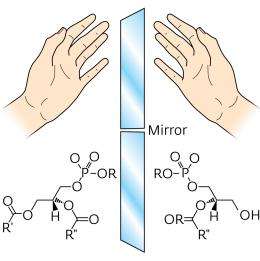Spectroscopic evidence for the unusual handedness of a mammalian lipid may advance our understanding of evolution

Phospholipids are the main constituents of the cellular membranes in all organisms, ranging from single-celled archaea to highly complex plants and mammals. According to conventional wisdom, the chemical backbone of phospholipids in archaea is ‘right-handed’, but left-handed in all other organisms (Fig. 1). The little-understood mammalian phospholipid bis(monoacylglycero)phosphate (BMP), however, is a possible exception to this rule. Peter Greimel, HuiHui Tan and their colleagues at the RIKEN Advanced Science Institute, Wako, have now obtained the first proof that BMP is indeed right-handed.
BMP is found only in mammals, and is a common—but minor—constituent of all animal tissues. The internal membranes of the waste treatment and recycling centers of cells—so-called late endosomes and lysosomes—have a higher proportion of BMP than any other animal membranes. This raised an intriguing question, explains Greimel: “How does BMP escape degradation inside these organelles, unlike all the other lipids and proteins?” This led to the [hypothesis] that BMP might actually be right-handed, allowing it to avoid attack by the organelle’s digestive enzymes that are only capable of recognizing, and therefore destroying, left-handed lipids. All previous attempts to confirm the suspected unusual handedness—or chirality—of BMP had hit problems.
The research team first synthesized all the possible variations of BMP. They then reacted these variations with the chiral shift reagent D-camphor. “The D-camphor induced a change in the spectroscopic behavior of each synthetic BMP analogue,” explains Greimel. This meant that the nuclear magnetic resonance (NMR)—a common spectroscopic technique—spectra of the BMP analogues were different enough to be distinguished from each other.
Next, the researchers isolated natural BMP from baby hamster kidney cells using standard techniques, then reacted it with D-camphor under very gentle conditions and analyzed it spectroscopically. They then compared the NMR spectra of the natural BMP derivative and the synthetic molecules. “Analysis of the spectroscopic data revealed that natural BMP is exclusively right-handed,” Greimel says.
“Since BMP is right-handed, it means it most likely originated from the same common ancestor as archaea,” he explains. The research team now plans to identify the enzymes involved in the biosynthesis of BMP, with the hope that detailed knowledge of this biosynthetic pathway will eventually lead to a better understanding of how life evolved on Earth.
Additionally, Greimel says that “now we know the [chirality] of the molecule, we can think about synthesizing analogues in order to develop novel drugs, in this case to treat lysosomal storage diseases.”
More information: Tan, H.-H., et al. Spectroscopic evidence for the unusual stereochemical configuration of an endosome-specific lipid. Angewandte Chemie International Edition 51, 533–535 (2012).
Provided by RIKEN



















